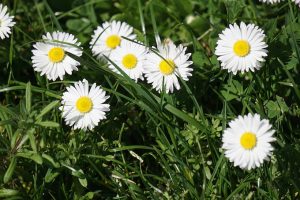Have you ever bemoaned the state of a patch of grass, be it your neighbour’s messy front lawn (admittedly front lawns are becoming a rare commodity too), a patch of rank grass in the park or an unkempt sidewalk? Then you’ll know that most people prefer to see a well-manicured lawn cut short and neat. I have to admit, a nice lawn that looks like a flawless green carpet is a lovely thing to behold but it is hard work to maintain. This is probably why we’ve seen increasing numbers of people putting down astroturf. If however, you care about wildlife, an immaculate green lawn is only marginally better than astroturf or concrete for wildlife.
This should be a concern for all of us because the numbers and types of insects appear to be declining more quickly than plants and vertebrates. Not a fan of insects? Think again, insects provide a wealth of services, they include bees that pollinate our food crops, butterflies, beetles and a myriad of creepy crawlies who, amongst other things, form the food source for vertebrates. They are a backbone to our web of life and if we lose them we are in danger of losing everything that relies on them.

A perfect lawn, little better than green concrete
The average, perfectly maintained lawn usually contains a monoculture, or at best two or three different types of grass. Most house proud lawn owners work tirelessly to remove any weeds they come across. A quick Google search for lawns brings up hundreds of pages of sites telling you exactly how to poison, rip up, burn and otherwise remove the weeds, i.e. plant variety from your lawn. If this is an activity you enjoy I won’t try to stop you. If, on the other hand, you find lawn maintenance a chore then consider this – a higher diversity (weedy) lawn is better for wildlife. There are around 37 common lawn weeds that will pop up in your lawn without any assistance from you thereby increasing the biodiversity of your lawn instantly and easily.
Many of these plants are really popular with bees. Have you ever seen a bumblebee bopping about a perfect lawn? I’ll bet the answer is no. Whilst a weedy lawn dotted with dandelions, daisies, red clover and self heal provides a veritable banquet for local bees. I have spent many pleasant moments watching bees hovering around the weedy lawn near the flats where I live. The weeds always just manage to get into flower before buildings maintenance comes along and scalps the lot leaving millimetre high fragments of grass, flowerless weeds and bare earth. It isn’t attractive and with a stroke, a mini jungle of nectar has been clear-felled.

Weedy lawn, there are at least 4 different species in this close up which is much better for biodiversity
So if I have convinced you that a weedy patch is better than a lawn but you are still concerned with neatness, consider leaving all your weeds, mowing slightly less frequently and set your mower higher so that it snips off the tops of the weeds but leaves a flowery base. If you want additional interest you can spot plant native wild marjoram, thyme and violas all of which are good nectar sources and attractive plants that can stand a degree of mowing. If you are concerned with unfavourable comments about your green weedy patch, put up a little notice board announcing your mini reserve and start counting and advertising the number of species you have in it. You’ll be astonished by how many different plants and animals you’ll start seeing.
You don’t need to stop there. Think about all the public green space we have, all those bits of close-mown grass we have around flats and along road verges. Except in mid-summer when they’re bright green and lush, for most of the time they are pretty sorry looking stretches of turf whose only function seems to be minimal provision of green space and as rain soakaways. Sending out machinery to mow all these disparate green spaces costs a small fortune which is one of the reasons why more and more of our public space is being paved. Paving is neater and cheaper to maintain but a disaster for wildlife and prevention of flooding. So maybe we need to reconsider our love affair with the neat and tidy and ask that our public realm is left a little longer, and allowed to be a little weedier. These small patches of green could then provide invaluable islands of resources that insects could scurry and flit amongst. That would do us and them some real good.
Letting your lawns grow weedier is a mini form of rewilding. Find out about rewilding on a grander scale at our biodiversity networking meeting on the 15th March, where the director from Rewilding Britain will be speaking about their work.
SaveSave



